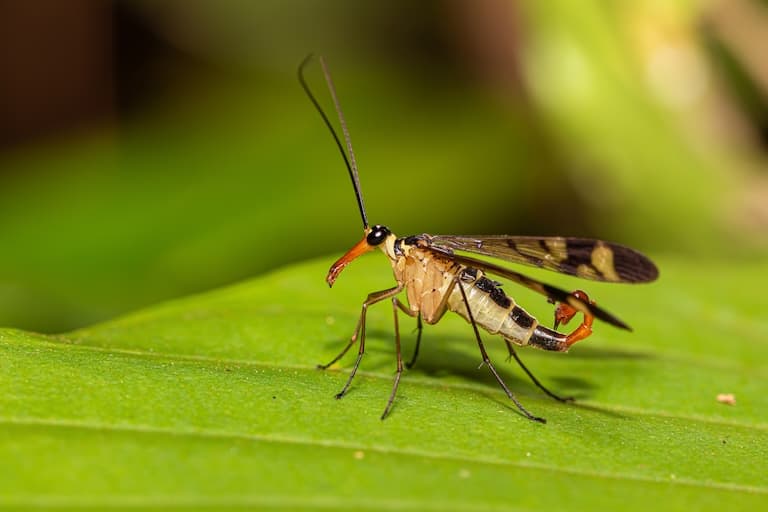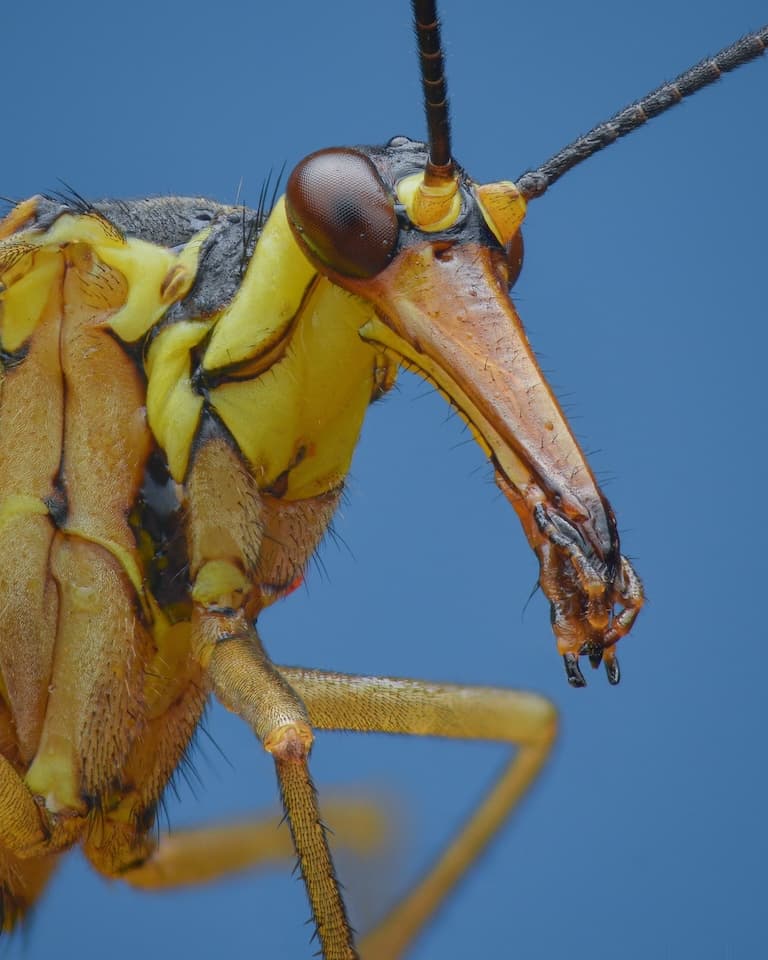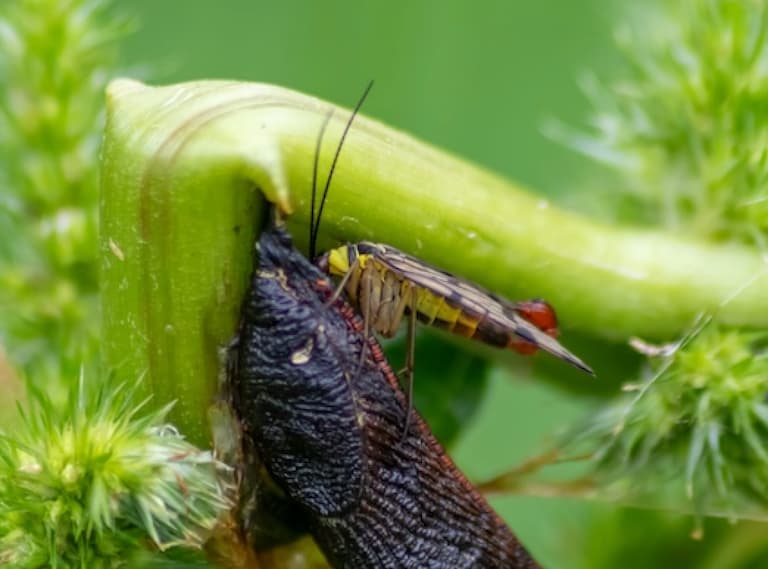Scorpionfly Profile
A winged scorpion has been a common manifestation of human fiction for thousands of years. The Persians went overboard and invented a flying lion with a scorpion’s tail. But as far as the fossil record and modern understanding of evolution suggest, there was never any winged arachnid.
So, the scorpionfly can’t be a real scorpion, and as it happens, it isn’t a real fly, either, ranking it up near the Ladybird for the title of “Most Misleading Name”.
While not quite as weird as a manticore, they are still very unusual animals.

Scorpionflies Facts Overview
| Habitat: | Moist, low shrubs and ground cover in densely-vegetated woodlands |
| Location: | Worldwide, not common on islands |
| Lifespan: | Around one year |
| Size: | 9 – 25 mm (0.4 in to 1 in) long, depending on the species. |
| Weight: | Not recorded |
| Colour: | Highly varied |
| Diet: | Dead and dying invertebrates, nectar, and rotting fruit |
| Predators: | Birds, bats, insects, mammals, reptiles |
| Top Speed: | Slow |
| No. of Species: | More than 480 |
| Conservation Status: | Not Listed |
Scorpionflies are a family of weird and primitive insects who wear their hearts on their sleeves and their balls on their backs. These winged relatives of the fleas are romantic in their own way, and generally harmless, though they are likely to nibble on the occasional human, post-mortem.
This makes them useful to forensic entomologists, and their phylogeny, while still being examined, may be very helpful in identifying the origins of true flies, too.
Interesting Scorpionfly Facts
1. They’re Mecopterans
Most animals are arthropods. By quite a wide margin, actually. And most arthropods are insects.
The most diverse insect orders are the beetles, which make up around 40% of all insects (and 25% of all animals); the butterflies and moths; the bees, ants and wasps; the true flies; and the true bugs. The most diverse insect groups appear to have co-evolved alongside flowering plants, creating an abundance of interesting strategies to take advantage of this new food source.
Most of the insects you can find in the garden fit into one of these orders, but there are still around 25 more orders of insects, some lesser known than others.
Scorpionflies make up the largest family within the order Mecoptera, or “Long wings”, and they look a lot like true flies, to which they’re closely related, but surprisingly, their only closer relatives appear to be the fleas. There are around 500 species in this family, and they’re dotted about all over the planet.
The “Scorpionfly” moniker can often be extended to the order itself, though it’s only the family Panorpidae that sports the characteristic, scorpion-like “stinger”, curved up over the abdomen.
This appendage isn’t used in defence, though, quite the opposite.
2. They have big genitals
The hooked and ominous appendage that gives this family its name may look like a venom gland, but it’s actually a gland of a very different nature.
The “stinger” on the back of male scorpionflies is actually its reproductive organs. They’re so big they have to be held up over their backs and are armed with a pair of claspers to aid in the mating process.
But if this wasn’t appealing enough to a female, the males have another package to offer.
3. Males offer spit jelly and farts

For the male, courtship involves more than just waving his enormous genitals around. A gift is often necessary, mostly to distract the female with food while he gets the job done.
A dead insect may do the trick, but often, a brown, sticky salivary jelly is produced as an offering to the female, coupled with the release of a persuasive pheromone from his swollen abdomen.
The female is overwhelmed by either or both of these gifts and drops her guard long enough for the male to take his share of the deal.
While there are human subcommunities who engage in a troublingly similar courtship exchange, the sexes are generally reversed and the transaction typically involves a financial component. 1
4. Their larvae are scavengers
It’s uncertain whether the female suffers any buyer’s remorse once the jelly has been consumed, but by then it’s too late, and her eggs will soon be laid in the soil to hatch into larvae within a few weeks.
There are four instars in the caterpillar-like larva’s development, followed by a complete metamorphosis into adults, and throughout this juvenile stage, the larvae will scavenge what scraps they can find, mostly eating dead insects.
Adults spend more time feeding on nectar, as their new ability to fly and relative lack of growth require a more carbohydrate-rich diet than the protein meals of the young.
5. They can jump
Being relatives of the common flea, the scorpionfly shares at least one similarity: its ability to jump.
This is almost unique among the order of the scorpionfly family, though there is one other species known to do it, known as the wingless snow flea.
Their hind legs are longer and built to propel the animal from the ground to a comfortable distance from it, where it can safely begin flapping.
This is a surprisingly powerful manoeuvre, exerting up to 10 g on the body of the insect. 2
6. They’re possibly ancestral
Both Lepidopterans (butterflies and moths) and Diperans (true flies) are thought to have evolved either from the Mecoptera order or from animals very close to it. This suggests that the scorpionflies are an ancestral version of many of the most important insects around us today.
Nobody’s quite sure when the split happened, but a group of transitional fossils suggest there were intermediate stages during the Mesozoic.
Even the current taxonomy is undecided, with some suggesting fleas belong within the Mecoptera clade and others saying they should be just beside it.
But another clue to their similarity to the infamous bloodsuckers is their penchant for nibbling on people.
7. They eat people

A stark difference between the attitudes of fleas and scorpionflies is displayed in how long they wait before feeding on people.
Fleas feeding on a person is a good sign that it’s a little early to call the forensic pathologists, but on the contrary, if there’s a scorpionfly munching on your toe, you’re likely too far gone to find out.
Where the family is common, scorpionflies can be the first at the buffet when a human dies, and this indicates to anyone who might be interested that the corpse is good and fresh.
Forensic entomologists have a whole shopping list of invertebrate species to look out for, each with a preferred level of decay – their presence is a good way to tell how long it’s been festering.
But scorpionflies are at least polite enough not to bite or eat live humans. 3
Scorpionfly Fact-File Summary
Scientific Classification
| Kingdom: | Animalia |
| Phylum: | Arthropoda |
| Class: | Insecta |
| Order: | Mecoptera |
| Family: | Panorpidae |
Fact Sources & References
- “Family Panorpidae – Common Scorpionflies”, BugGuide.
- M. Burrows (2019), “Jumping and take-off in a winged scorpion fly (Mecoptera, Panorpa communis)”, Journal of Experimental Biology.
- Poncie Rutsch (2015), “Finding Crime Clues In What Insects Had For Dinner”, npr.
